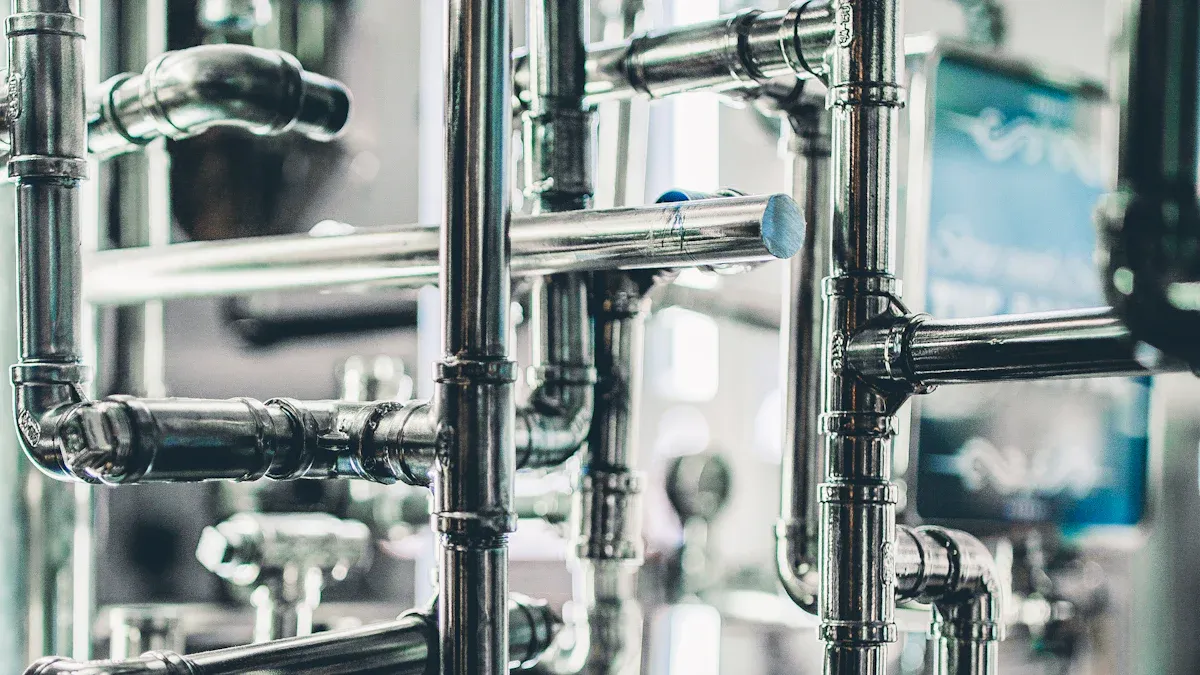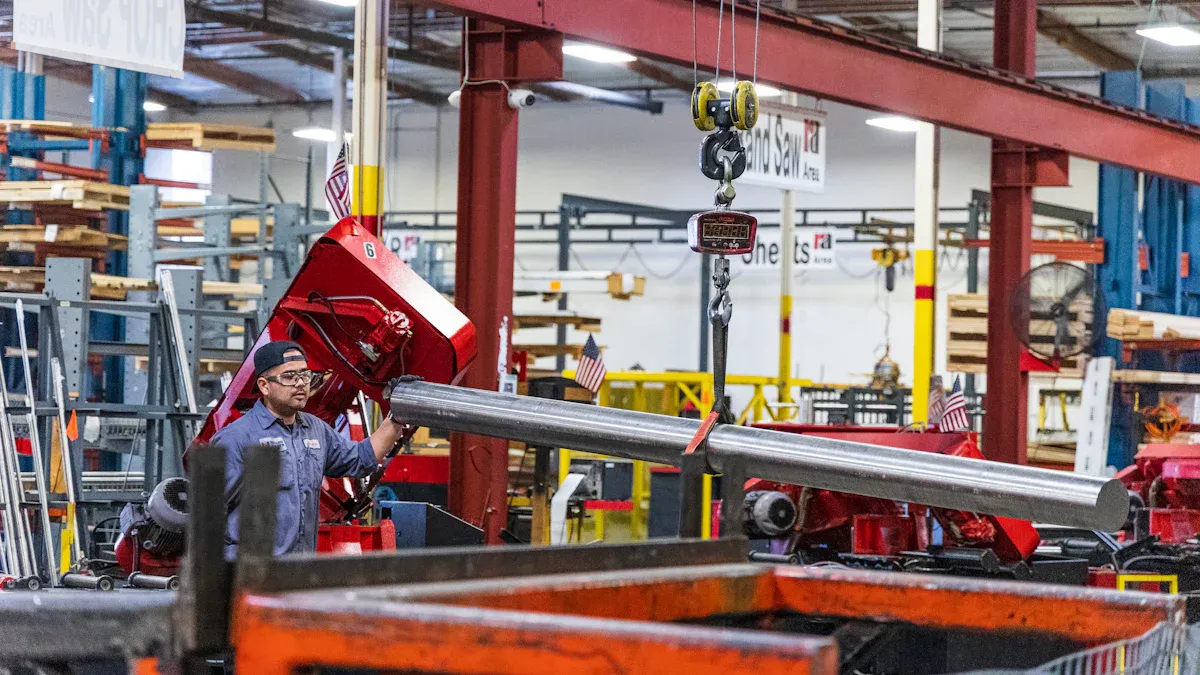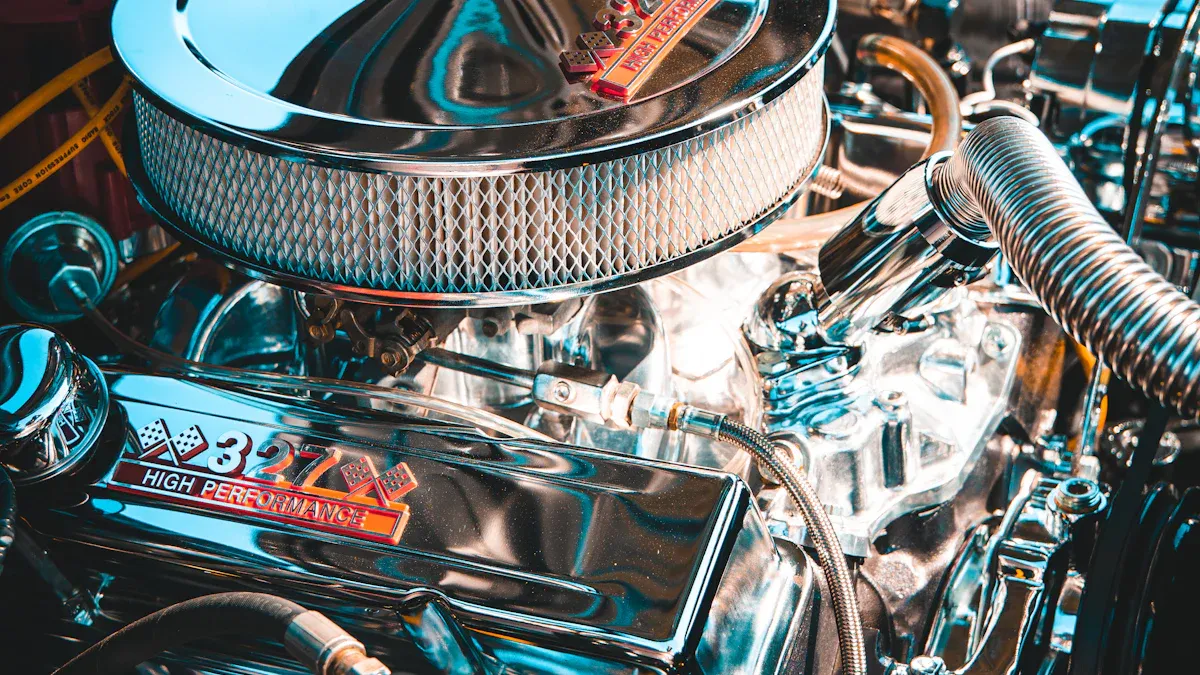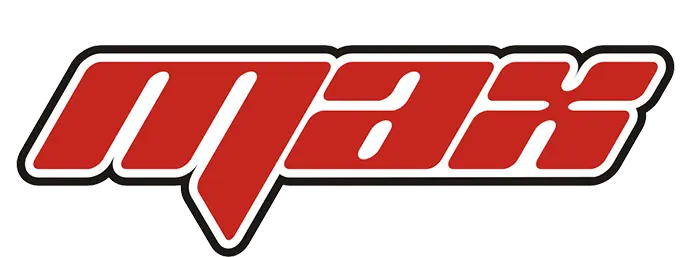
Induction hardened chrome rods combine advanced engineering techniques to deliver exceptional performance. These induction hardened chrome rods undergo a specialized process that strengthens their surface by heating and rapidly cooling it. A durable chrome layer is then applied to protect against rust and wear. You’ll find induction hardened chrome rods indispensable in industries where durability and reliability are crucial.
Their enhanced features include a chrome layer thickness starting at 20 microns, hardness levels reaching up to 1150 HV, and straightness precision of ≤0.2/1000. These qualities ensure induction hardened chrome rods endure demanding conditions while maintaining consistent performance. From hydraulic systems to aerospace technologies, induction hardened chrome rods meet the needs of modern applications.
What Are Induction Hardened Chrome Rods?
Definition and Overview
Induction hardened chrome rods are steel rods that undergo two specialized processes: induction hardening and chrome plating. Induction hardening strengthens the rod’s surface by heating it with electromagnetic induction and rapidly cooling it. This process creates a hardened layer that resists wear and impact. Chrome plating adds a protective layer to the rod, enhancing its resistance to corrosion and environmental damage.
These rods are designed for applications requiring high durability and reliability. Industries such as automotive, construction, and aerospace rely on induction hardened chrome rods for their ability to perform under stress and harsh conditions. Their precision engineering ensures consistent performance, even in demanding environments.
Tip: If you need materials that combine strength, corrosion resistance, and longevity, induction hardened chrome rods are an excellent choice.
How Induction Hardening Enhances Durability
Induction hardening transforms the surface of steel rods into a tough, wear-resistant layer. The process involves heating the rod’s surface using electromagnetic induction and then cooling it rapidly. This rapid cooling, known as quenching, alters the steel’s microstructure, increasing its hardness and strength.
- Key Benefits of Induction Hardening:
- Enhanced impact resistance: The hardened surface withstands heavy loads and sudden shocks.
- Improved wear resistance: The rods resist abrasion, making them ideal for high-impact environments.
- Increased longevity: The hardened layer ensures the rods last longer, even in challenging conditions.
Compared to conventional steel rods, induction hardened chrome rods offer superior mechanical properties. Their surface hardness reaches a minimum of HRc 50, with a hardened case depth of at least 0.050″. This makes them suitable for industries like construction and manufacturing, where durability is critical.
Role of Chrome Plating in Corrosion Resistance
Chrome plating plays a vital role in protecting induction hardened chrome rods from corrosion. The plating process involves applying a thin layer of chromium to the rod’s surface, creating a barrier against moisture, chemicals, and environmental factors.
- Quantitative Test Results:
- Salt spray tests confirm the effectiveness of chrome plating in resisting corrosion.
- Chromium plating thickness ranges from 51-127 μm (2-5 mils), providing robust protection for hardened steel rods.
- Both Cr(III) and Cr(VI) coatings demonstrate excellent adhesion and comparable corrosion resistance.
This protective layer ensures the rods maintain their performance in harsh conditions, such as exposure to water, chemicals, or extreme temperatures. Whether you’re working with hydraulic systems or heavy machinery, chrome plating enhances the reliability of induction hardened chrome rods.
Note: The combination of induction hardening and chrome plating makes these rods a top choice for industries requiring both strength and corrosion resistance.
Key Features of Induction Hardened Chrome Rods

Surface Hardness and Case Depth
The surface hardness and case depth of induction hardened chrome rods are critical to their durability and performance. Induction hardening creates a harder surface by altering the steel’s microstructure through rapid heating and cooling. This process ensures the rods can withstand heavy loads and resist wear over time.
Surface hardness for these rods typically reaches a minimum of Rc 50, with an effective case depth of at least 0.050 inches. These properties make them ideal for applications requiring high fatigue strength and resistance to deformation. The following table highlights key laboratory results and industry standards for surface hardness and case depth:
| Property | Value |
|---|---|
| Surface Hardness | Rc 50 minimum |
| Effective Case Depth | 0.050″ minimum |
| Yield Strength | Approx. 100,000 P.S.I. |
| Elongation | 10% |
| Reduction of Area | 38% |
| Finish | 12/15 RMS |
This combination of hardness and depth ensures the rods maintain their structural integrity under stress, even in harsh environments. Whether you need components for hydraulic systems or heavy machinery, these features provide the reliability you require.
Wear Resistance and Longevity in High-Impact Environments
Induction hardened chrome rods excel in wear resistance, making them indispensable in high-impact environments. The hardened surface created by induction hardening resists abrasion and minimizes material loss during operation. This durability extends the lifespan of the rods, reducing the need for frequent replacements.
Studies show that chrome plating enhances the fretting fatigue life of steel components by up to 60%. This improvement directly impacts the rods’ ability to endure repeated stress cycles without cracking or deforming. Key findings include:
- Chrome plating increases the cycles required for crack initiation.
- Hardened surfaces reduce visible plastic deformation zones.
- Fatigue strength improves significantly, ensuring fewer failures over time.
These features make induction hardened chrome rods a cost-effective solution for industries like construction and manufacturing, where equipment faces constant wear and tear.
Corrosion Resistance for Harsh Conditions
A layer of corrosion resistance is essential for rods exposed to harsh environments. The chrome plating on induction hardened chrome rods acts as a protective barrier, shielding the steel from moisture, chemicals, and extreme temperatures. This layer ensures the rods maintain their performance even in the most challenging conditions.
Environmental exposure tests, such as Electrochemical Impedance Spectroscopy (EIS) and Linear Polarization Resistance (LPR), confirm the rods’ superior corrosion resistance. These tests evaluate the rods’ ability to withstand corrosive elements over extended periods. The table below summarizes key findings:
| Test Type | Description |
|---|---|
| Electrochemical Impedance Spectroscopy (EIS) | Measures interfacial electrical resistance in CO2-saturated electrolyte to assess corrosion behavior. |
| Linear Polarization Resistance (LPR) | Monitors corrosion potential and resistance at defined intervals, providing statistical data on corrosion rates. |
| Test Duration | Initial tests lasted 7 days, with extended tests for specific samples up to 28 days. |
| Sample Variations | Tests included samples with varying chromium content (0Cr, 1Cr, 3Cr) to evaluate the impact on corrosion resistance. |
| Observations | Results indicated that corrosion resistance varied significantly with chromium content, with sample 3Cr showing higher initial resistance. |
These results demonstrate the rods’ ability to resist corrosion effectively, ensuring long-term reliability. Whether used in hydraulic systems or aerospace applications, the combination of induction hardening and chrome plating provides unmatched protection against environmental damage.
Technical Specifications (e.g., material composition, hardness levels)
Understanding the technical specifications of induction hardened chrome rods helps you evaluate their suitability for your applications. These rods are crafted using high-quality steel grades and undergo rigorous testing to ensure optimal performance. Below, you’ll find detailed insights into their material composition and testing methods.
Material Composition
The steel grades used in induction hardened chrome rods are carefully selected to balance strength, wear resistance, and machinability. Each grade offers unique properties tailored to specific industrial needs. The table below outlines the chemical composition of commonly used steel grades:
| Material | C% | Mn% | Si% | S% | P% | V% | Cr% |
|---|---|---|---|---|---|---|---|
| Ck45 | 0.42-0.50 | 0.50-0.80 | 0.17-0.37 | ≤0.035 | ≤0.035 | ≤0.25 | |
| ST52 | ≤0.22 | ≤1.6 | ≤0.55 | ≤0.04 | ≤0.04 | 0.02-0.15 | |
| 20MnV6 | 0.17-0.24 | 1.30-1.70 | 0.10-0.50 | ≤0.035 | ≤0.035 | 0.10-0.20 | ≤0.30 |
| 42CrMo4 | 0.38-0.45 | 0.50-0.80 | 0.17-0.37 | ≤0.035 | ≤0.035 | 0.07-0.12 | 0.90-1.20 |
| 40Cr | 0.37-0.45 | 0.50-0.80 | 0.17-0.37 | ≤0.035 | ≤0.035 | 0.80-1.10 |
These compositions ensure the rods achieve the necessary hardness and durability for demanding environments. For example, 42CrMo4 provides excellent tensile strength and fatigue resistance, making it ideal for hydraulic systems and heavy machinery.
Testing Methods
To guarantee the quality of induction hardened chrome rods, manufacturers use advanced testing equipment. These tools verify the rods’ material properties and ensure they meet industry standards. Key testing methods include:
- XRF Spectrometer: This device analyzes the chrome plating’s composition, ensuring the purity and consistency of the protective layer.
- Eddy Current Thickness Gauge: It measures the thickness of the chrome coating, confirming uniformity across the rod’s surface.
- Rockwell Hardness Tester: This tool evaluates the surface hardness, which is critical for wear resistance and longevity.
- Rotary Wear Tester: It assesses the durability of the chrome layer under mechanical stress, simulating real-world conditions.
These tests validate the rods’ ability to withstand high-impact environments and resist corrosion effectively. For instance, the Rockwell Hardness Tester confirms that the rods achieve a minimum hardness level of Rc 50, ensuring they perform reliably under heavy loads.
Why These Specifications Matter
The combination of precise material composition and rigorous testing ensures induction hardened chrome rods deliver consistent performance. Whether you need rods for hydraulic systems, manufacturing machinery, or construction equipment, these specifications guarantee durability and reliability. By understanding these technical details, you can make informed decisions about the materials you choose for your projects.
Applications of Induction Hardened Chrome Rods

Hydraulic Systems and Cylinders
Induction hardened chrome rods play a vital role in high-performance hydraulic systems. These rods provide the structural integrity needed to handle high-pressure environments. Hydraulic cylinders rely on their exceptional load-bearing capacity to operate efficiently in demanding conditions. The hardened surface resists wear, ensuring the piston rods maintain their performance over time.
The chrome plating enhances corrosion resistance, making these rods ideal for hydraulic cylinders exposed to moisture or chemicals. Their precision engineering ensures smooth operation, reducing friction and extending the lifespan of hydraulic systems. Whether used in construction equipment or industrial machinery, induction hardened piston rods deliver consistent results.
Tip: For applications requiring durability and reliability, induction hardened chrome rods are the perfect choice for hydraulic cylinders.
Construction and Heavy Equipment
In construction and heavy equipment, induction hardened chrome rods provide unmatched durability. These rods withstand heavy loads and harsh conditions, ensuring the structural integrity of hydraulic cylinders and other components. Field tests demonstrate their effectiveness in reducing costs and improving performance:
- Friction welding achieves 15% cost savings.
- Piston rod strength increases by 20%.
- Joint properties match the strength of parent materials.
| Type of Rod | Key Features | Applications |
|---|---|---|
| Carbon Steel | Excellent balance between strength and cost efficiency | Hydraulic cylinders in construction equipment |
| Alloy Steel | Enhanced mechanical properties, fatigue and wear resistance | Heavy-duty applications like industrial presses and mining machinery |
| SAE1045 Induction Hardened Chrome Plated Rod | High tensile strength and durability | Suitable for demanding operational conditions in construction and heavy equipment |
These rods excel in heavy-duty applications, such as industrial presses and mining machinery. Their ability to resist wear and corrosion ensures long-term reliability, even in extreme environments. By choosing induction hardened piston rods, you can improve the efficiency and durability of your equipment.
Manufacturing Machinery and Automation
Induction hardened chrome rods are essential for manufacturing machinery and automation systems. Their high load-bearing capacity allows them to handle repetitive stress without compromising performance. Piston rods in automated systems require precision and durability, which these rods provide through their hardened surface and chrome plating.
The rods’ wear resistance ensures smooth operation, reducing downtime and maintenance costs. Their corrosion resistance makes them suitable for environments with exposure to chemicals or moisture. Industries like automotive and aerospace benefit from their ability to maintain structural integrity under constant use.
Note: Induction hardened chrome rods enhance the efficiency and reliability of manufacturing machinery, making them indispensable for automation applications.
Automotive and Aerospace Industries
Induction hardened chrome rods play a crucial role in the automotive and aerospace industries. These sectors demand components that can endure extreme conditions while maintaining precision and reliability. Piston rods, strengthened through induction hardening and protected by chrome plating, meet these requirements with exceptional performance.
In the automotive industry, piston rods are essential for shock absorbers, steering systems, and engine components. Their hardened surfaces resist wear caused by constant motion and friction. This durability ensures that vehicles operate smoothly, even under heavy loads or challenging terrains. Chrome plating adds another layer of protection, preventing corrosion from exposure to moisture, road salts, and chemicals. For example, in off-road vehicles, these rods withstand repeated impacts and environmental stress without compromising functionality.
The aerospace industry also relies heavily on induction hardened piston rods. Aircraft landing gear systems, hydraulic actuators, and control mechanisms require components that can handle high pressure and extreme temperatures. The hardened surface of these rods resists deformation during takeoff and landing, where forces are at their peak. Chrome plating ensures long-term resistance to oxidation and corrosion, even in high-altitude environments where atmospheric conditions are harsh.
Both industries benefit from the precision engineering of these rods. Their straightness and surface finish reduce friction, improving energy efficiency and extending the lifespan of mechanical systems. By choosing induction hardened piston rods, you ensure reliability and safety in critical applications.
Tip: Whether you’re designing vehicles or aircraft, these rods provide the strength and durability needed for demanding applications.
Manufacturing Process of Induction Hardened Chrome Rods
Induction Hardening Process and Its Benefits
The induction hardening process transforms steel rods into durable, high-performance components. This specialized manufacturing process begins by heating the rod’s surface using electromagnetic induction. The rapid heating is followed by immediate cooling, or quenching, which alters the steel’s microstructure. This creates a hardened surface layer while maintaining a tough core.
The benefits of induction hardening are evident in the technical performance metrics:
| Metric | Benefit |
|---|---|
| Improved Strength | Increases hardness and strength, leading to higher resistance to deformation. |
| Wear Resistance | Enhances resistance to sliding abrasion, suitable for tough environments. |
| Fatigue Life | Extends lifespan by reducing tiny cracks due to cyclic loading. |
| Corrosion Resistance | Provides protection against corrosive environments, reducing maintenance costs. |
| Selective Hardening | Allows targeted hardening of specific areas for enhanced performance. |
This process ensures that induction hardened piston rods deliver exceptional durability and wear resistance. You’ll find these rods ideal for applications requiring improved fatigue strength and load-bearing capacity.
Chrome Plating Process for Enhanced Performance
After hardening, the rods undergo chrome plating to enhance their performance further. This process involves applying a thin chromium layer to the rod’s surface. The chrome layer acts as a protective barrier, shielding the rod from corrosion, moisture, and environmental damage.
The plating process also improves the rod’s surface finish, reducing friction and wear during operation. This makes the rods suitable for high-impact environments, such as hydraulic systems and heavy machinery. The combination of induction hardening and chrome plating ensures the rods maintain their structural integrity and reliability over time.
Tip: Chrome plating not only enhances corrosion resistance but also extends the lifespan of the rods, reducing maintenance costs in the long run.
Quality Control and Testing Standards
Quality control is a critical step in the manufacturing process of induction hardened chrome rods. Rigorous testing ensures that each rod meets industry standards and performs reliably in demanding applications.
Key certifications and benchmarks include:
| Standard | Description |
|---|---|
| ASTM E18 | Standard Test Methods for Rockwell Hardness of Metallic Materials. |
| ISO 6508 | Metallic materials — Rockwell hardness test. |
| EN 10278 | Calibration and verification of hardness testing machines. |
| ASTM E94 | Standard Practice for Calibration of Rockwell Hardness Testing Machines. |
Manufacturers also test material properties like tensile strength and yield strength. For example:
- Material types: 42CrMo4, 40Cr, CK45, ST52, 20MnV6
- Minimum tensile strength: 610 N/MM²
- Minimum yield strength: 355 N/MM²
These stringent quality checks ensure that induction hardened chrome rods meet the highest performance standards. By choosing rods that adhere to these benchmarks, you can trust their durability and reliability in critical applications.
Benefits of Using Induction Hardened Chrome Rods
Enhanced Durability and Performance in Demanding Applications
Induction hardened chrome rods deliver enhanced durability, making them ideal for demanding applications. The process of induction hardening strengthens the rods’ surface, allowing them to resist wear and impact. This durability ensures they perform reliably in environments where heavy loads and constant motion are common.
The chrome plating adds another layer of protection, shielding the rods from corrosion caused by moisture or chemicals. You’ll find these rods particularly useful in industries like construction and manufacturing, where equipment faces harsh conditions daily. Their superior performance ensures fewer replacements and less downtime, saving you time and resources.
Tip: If your applications require components that can endure stress and harsh environments, induction hardened chrome rods are a dependable choice.
Cost-Effectiveness for Long-Term Use
Induction hardened chrome rods offer significant cost savings over time. Their durability reduces the need for frequent replacements, lowering maintenance expenses. The manufacturing process also allows for cost-efficient designs, such as thinner chrome layers that still provide sufficient corrosion protection.
- How They Save Costs:
- Improved mechanical properties reduce wear and tear, extending the rods’ lifespan.
- Smaller diameters lower material costs without compromising strength.
- Stronger materials lead to a cost reduction of up to 30% compared to standard options.
These features make induction hardened chrome rods a smart investment for industries seeking long-term solutions. By choosing these rods, you can optimize your budget while maintaining high performance in your operations.
Versatility Across Multiple Industries
Induction hardened chrome rods are versatile, serving a wide range of industries. Their durability and wear resistance make them suitable for high-stress applications, such as hydraulic systems and heavy machinery. You’ll also find them in automotive and aerospace sectors, where precision and reliability are critical.
- Industries Benefiting from These Rods:
- Automotive: Components like shock absorbers and steering systems rely on their ability to withstand wear and stress.
- Construction: Rising investments in durable equipment drive demand for these rods.
- Manufacturing: Tailored solutions meet specific operational needs in automated systems.
This versatility ensures that induction hardened chrome rods adapt to various applications, providing consistent performance across industries. Whether you need them for hydraulic systems or aerospace technologies, their enhanced durability makes them a reliable choice.
Induction hardened chrome rods stand out for their exceptional durability, wear resistance, and corrosion protection. These features make them reliable in demanding environments, ensuring long-lasting performance. Their ability to endure heavy loads and resist environmental damage makes them indispensable across industries.
- Key Applications:
- Hydraulic systems
- Construction equipment
- Manufacturing machinery
- Automotive and aerospace technologies
Why Choose Them? You gain a material that combines strength, precision, and longevity. Whether you need components for heavy machinery or advanced automation, these rods deliver unmatched reliability. Explore how they can elevate your projects today!
FAQ
What makes induction hardened chrome rods different from standard steel rods?
Induction hardened chrome rods have a hardened surface and a chrome-plated layer. This combination provides superior wear resistance, corrosion protection, and durability. Standard steel rods lack these enhancements, making them less suitable for demanding applications.
Tip: Choose induction hardened chrome rods for environments requiring high strength and longevity.
Can induction hardened chrome rods be customized for specific applications?
Yes, manufacturers offer customization options. You can specify dimensions, material grades, and chrome thickness to meet your project’s needs. This flexibility ensures the rods perform optimally in your unique application.
Example: Hydraulic systems often require rods with precise straightness and surface finish.
How do you maintain induction hardened chrome rods?
Regular cleaning and lubrication help maintain their performance. Use non-abrasive cleaners to remove dirt and debris. Inspect the rods periodically for signs of wear or damage.
Note: Proper maintenance extends the lifespan of the rods and reduces downtime.
Are induction hardened chrome rods environmentally friendly?
Yes, many manufacturers use eco-friendly chrome plating processes. These methods reduce harmful emissions and comply with environmental regulations. Always check if the supplier follows sustainable practices.
Did You Know? Cr(III) coatings are safer for the environment compared to Cr(VI) coatings.
Where can you purchase high-quality induction hardened chrome rods?
You can source them from reputable manufacturers specializing in industrial components. Look for companies with certifications like TS16970 and a proven track record of quality and customer satisfaction.
Pro Tip: Verify the supplier’s testing standards to ensure you receive reliable products.
